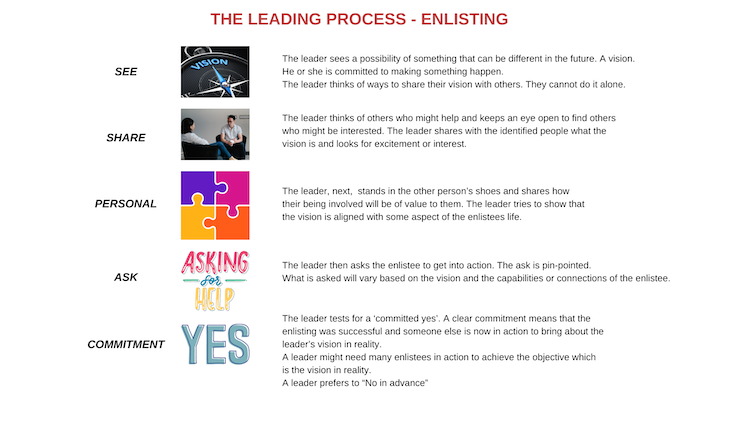In a previous article https://triumphantman.com/am-i-a-leader-or-a-manager/ I described the role of a MM as ‘manaleader’, meaning that you are both a manager and a leader. I drew the distinction between the two.
In this article I want to share with you the process for leading. Remember all work is a process https://triumphantman.com/all-work-is-a-process-dont-like-the-results-change-the-process/.
The leader imagines a different future. The leader sees something that can be created that does not now exist. It could be a new or improved product or a service, a high performing team, increased rate of sales, a better process, an affordable electric car or truck or anything.
What is important is that the leader is passionate about what he or she imagines and is determined to make it a reality.
What is imagined is called a ‘vision’. It is a vision personal to the leader.
By definition the leader will be unable to make their vision a reality without others getting into action to help. If you do not need others to help make it a reality, then just do it. You do not need to lead others into action.
A leader has a vision and needs others to get into action to make it a reality.
There is a single competency that a leader needs to do this.
I call it enlisting.

Enlisting
We thinking of enlisting as someone volunteering to join the army or navy or airforce. Some countries make you join – that is conscription and is not voluntary.
Volunteering is the key word to think of when enlisting others.
A major company I worked in had employees who were considered for a senior role choose a charity and take on a project for that charity that required them to lead volunteers. It was a very different experience for them to work with volunteers rather than direct reports. The concept of being able to ‘tell people what to do’ was absent.
It is the same for leaders, even if some of the people that need to get into action are direct reports, you want to enlist them as if they were volunteers.
As all work is a process, you will not be surprised to learn that there is a process for enlisting.
The image below captures that process. You can also download it in pdf format from this link:

Enlisting step by step
Step One: See.
It is one thing to have a vision, it is another to be able to explain it to someone else so that they get it. As you will need to share the vision with others it is important that you can explain it in a way that others can understand it or ‘see’ it as you do.
The vision is the engine that will drive the leader and others to get into action.
An oft quoted Einstein statement suggests that if you cannot explain it to a 6 year old that they can understand it, you do not understand it yourself. I take from this statement that if a leader cannot explain what they see as possible so that others get it, then maybe their vision in not fully understood by themselves.
For example: If a leader wants to create a high-performing team, it is not enough to say I want to create a high performing team. He or she will need to paint a picture of what it means to be a high performing team. Some aspects of it might be: Everyone aligned with what the team needs to achieve, team members supporting each other as needed, all members deliver on promises made, each member to have a role that leverages their strengths, open and frank discussions, everyone is equal and so on.
The leader might takes those thoughts and wrap them in a single sentence: I see the possibility that we will, together, create a team that will be successful because we respect and support each other as equal voices, in which each has a role on which the team depends and we hold each other accountable for delivering on promises made.

Step Two: Share
A leader embarking on the journey of making their vision a reality will first list whom he or she needs to enlist.
Depending on the scope of the vision the leader might not be able to name all those who will be needed. If it is the team example it is clear that all team members and maybe some others people will make the list. If it is to change the culture in a department of over a 100 people, it might not be all that clear. More names will come up as leader goes about enlisting.
This sharing step is simply that. Talking to the people on the list and sharing the vision using the words that have formed as you imagined the vision.
In this enlisting step you are looking for shared excitement, even a little. DO not be discouraged. Some people will be enthusiastic from the get go. Others might be sceptical. Still others might push back and argue that you vision will never happen. You are looking for early adopters and for those who you feel will be on board as soon as a little momentum is underway.
Step Three: Personal

This step requires that you think as if you are the enlistee. The two questions you think about are:
Why is my vision important to the enlistees?
What will they get out of it?
I was coached the headmaster of a private school in Canada. His vision was to create the best school in the world. He had a record in government schools of achieving great things – almost all students succeeding. Fewer drug problems that other schools. Happy parents and teachers.
In the private school he shared with me one problem. The problem was that the janitor was not onside. When the weather produced snow and icy conditions the janitor would only begin clearing the walkways and driveways AFTER all the students were at school, for example. We spoke about enlisting and the next time I met with him he was excited by what had happened. He had called in the janitor and shared with him his vision of the best school in the world.
He had shared (Step Two) and then he asked the Janitor to take the day off and think about the question: “What would it be like to be the janitor in the best school in the world?’ The janitor came back the next day totally excited and the short version of what happened id that the janitor was voted the Most Valuable Player in creating the vision in reality, that year.
That is one way of getting enlistees to think about how they will profit from being part of the vision creating process. Another is to help them see why the vision is so important and how it might be of value to them. The more someone can see themselves in
Step Four and Five : Ask and Commitment
Asking for someone to take on responsibility to do something is a litmus test for a leader. The leader must be comfortable with receiving a ‘no’. I introduced this concept in an earlier article entitled Triumph at Delegating for Results which can be read here. https://triumphantman.com/triumph-at-delegating-for-results/. I captured the concept as al leader would “rather ‘NO in advance.
Asking is the same process as delegating as described in the above article.
Given that the intention is to enlist someone into acting to support the vision, asking in a clear, pinpointed way is crucial. If they provided a committed “yes” then the enlistment has been successful. If the reply is ‘no’, then the leader needs to enlist someone else.
Sometimes an enlistee will be happy to support the realization of the leader’s vision in a way different to what the ask is. Given this possibility a leader might ask, following a ‘no’ answer, ‘Is there some other way you might be able to help?’. Or words to that effect.

Summary
Enlisting is the key capability for a leader. It requires courage to meet , share and ask people to help make the vision a reality.
A leader does not give up easily in the face of ‘no’s’.
The more times a leader attempts to enlist others, the faster the dream will become a reality.

